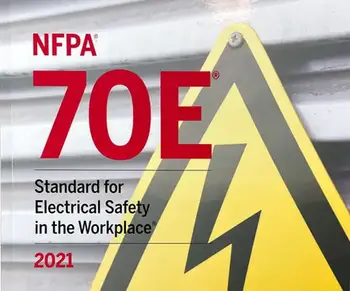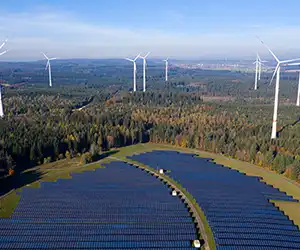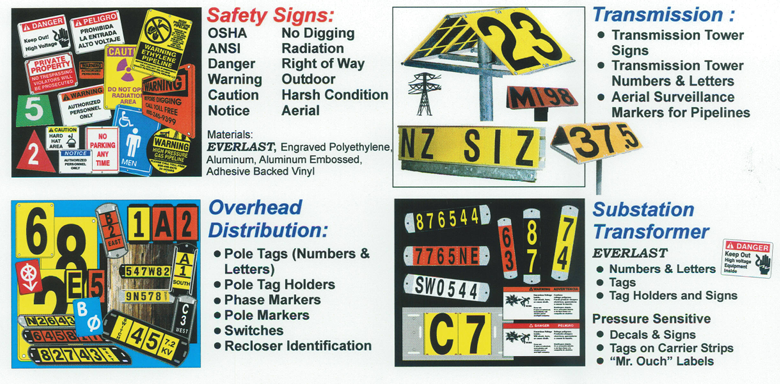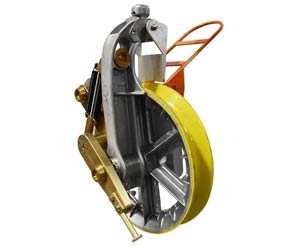Energy Storage

Hydrogen Energy Storage And Renewable Energy
Hydrogen energy storage converts renewable energy into hydrogen for long-term use, balancing supply, supporting grid stability, and enabling clean fuel applications across power generation, industry, and transportation.
What is Hydrogen Energy Storage?
Hydrogen energy storage is the process of producing hydrogen (H) through electrolysis, storing it, and later using it for electricity generation, heating, or as fuel.
✅ Enables renewable energy integration and grid flexibility
✅ Provides long-term, large-scale electric power storage capacity
✅ Supports decarbonization in power, industry, and transport
The Role of Hydrogen in the Energy Transition
Hydrogen energy storage (HES) is widely recognized as a promising solution for transitioning to clean and sustainable energy. It provides a way to store renewable power for extended periods, helping to stabilize power systems and reduce greenhouse gas emissions. Although hydrogen storage still faces challenges related to cost, efficiency, and safety, ongoing research and development are steadily improving performance and driving down expenses. The United States Department of Energy, along with international partners, continues to invest heavily in advancing H technologies. Hydrogen energy storage is part of a broader family of energy storage systems that provide critical solutions for balancing supply and demand in modern power grids.
Why Hydrogen is a Unique Energy Carrier
Unlike batteries or other containment systems, H has unique properties that make it well-suited for long-term, large-scale energy containment. It can be produced from diverse renewable resources such as wind and solar, then stored for later use without significant electrical loss. Hydrogen is non-toxic, non-corrosive, and can be transported through pipelines or delivered via tanker trucks. The integration of H with energy storage and the grid presents new opportunities to enhance resilience and facilitate the adoption of renewable energy on a large scale.
Advantages of Hydrogen as an Energy Carrier
Hydrogen stands out as an electricity carrier because it can be produced from diverse renewable sources and stored for long periods without losing its potential. It is non-toxic, non-corrosive, and transportable by pipeline or tanker, making it suitable for use in power generation, transportation, and various industrial uses.
Its advantages include:
-
Ability to support long-duration energy storage needs
-
Flexibility across sectors such as power generation, transport, and industry
-
Potential to supply clean, emission-free energy at scale
While batteries dominate today’s market, battery energy storage systems have limitations that H can complement, especially for long-duration and utility-scale applications.
Challenges in Hydrogen Storage
Despite its promise, hydrogen storage presents several obstacles. The most pressing issue is its low power density, which requires greater containment space than conventional fuels. High production and transportation costs also hinder large-scale deployment. Safety is another concern, as H is highly flammable and must be handled with care during storage and distribution.
Innovations in electrolysis, containment technology, and distribution networks are helping to address these issues. Efficiency improvements, new materials for containment, and safer handling methods are steadily advancing the field, making H a more competitive option for energy storage.
Technologies for Hydrogen Storage
Several methods are used to store hydrogen, each offering unique strengths depending on scale and application:
-
Compressed hydrogen storage – high-pressure tanks, often used for small or medium-scale applications. Other innovative methods such as compressed air energy storage and gravity energy storage highlight the range of technologies being developed to meet different grid and industrial needs.
-
Liquid hydrogen storage – cryogenic cooling that increases energy density but requires specialized insulated tanks.
-
Metal hydride storage – metals that absorb and release H, useful for compact systems.
-
Salt cavern storage – large underground formations capable of storing vast amounts of H for utility-scale needs.
These containment technologies enable the application of H across diverse industries, from powering fuel cell vehicles to supporting renewable-heavy grids.
When viewed in comparison to other containment technologies, H offers unique benefits. Unlike batteries, which degrade over time and have a limited containment duration, H can store electrical power indefinitely with minimal losses. Unlike pumped hydro, which requires specific geographic features, H systems can be deployed in a variety of locations, making them more versatile and adaptable. This flexibility makes H particularly well-suited for addressing the intermittency challenges of renewable power sources, such as wind and solar.
Future Applications of Hydrogen Energy Storage
As technology matures and costs decline, H is poised to play a central role in the future of the grid. Its versatility allows it to support multiple sectors simultaneously, providing clean power for electricity grids, transportation systems, and industrial processes.
Potential applications include:
-
Power generation and backup supply for critical infrastructure
-
Clean fuel for vehicles, trains, ships, and potentially even aircraft
-
Industrial processes requiring high-temperature heat and a continuous power supply
As nations pursue a clean power transition, comparisons between H and other approaches like long-term energy storage and solar energy storage help identify the most effective paths forward.
Looking Ahead
Modern hydrogen storage systems are evolving rapidly, with advanced solutions capable of storing H at pressures up to 700 bar. This form of pressure-based hydrogen storage is crucial to the development of next-generation H and fuel cell technologies, particularly in transportation, where vehicles must be hydrogen-fueled to achieve extended driving ranges. However, this approach requires high-pressure containment, making design and safety critical to its success. Different containment methods, including liquid H and metal hydrides, are being researched alongside compression, but 700-bar tanks remain one of the most widely deployed solutions in today’s industry.
Hydrogen is increasingly viewed as a cornerstone of the clean electric power transition. Its ability to store vast amounts of renewable energy, its scalability, and its adaptability make it one of the most promising solutions for decarbonizing global power systems. While challenges remain, the pace of innovation and investment in hydrogen energy containment suggests that its role will expand significantly in the coming decades, helping to build a more resilient, sustainable, and low-carbon future.
Related Articles
Download Our FREE Smart Grid Handbook
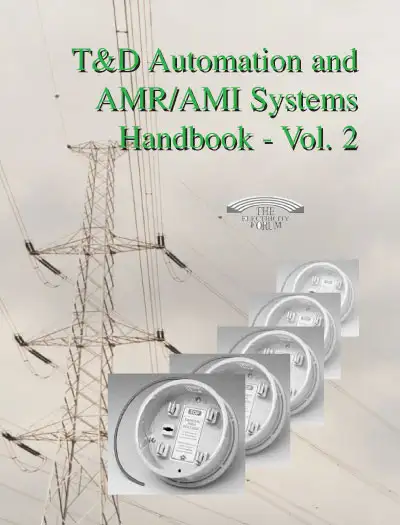
T&D Automation and AMR/AMI Systems Handbook Vol. 2
Volume 2 of our T&D Automation and AMR/AMI handbook series provides detailed information on the automation of the transmission and distribution networks, coupled with the widespread use of new metering technologies. Distributed generation, the cost benefit of modern substation automation, advanced metering infrastructure, intelligent switchgear and wireless technologies are a sampling of the articles included in this more than 104 page handbook.
The T&D Automation and AMR/AMI Systems Handbook, Vol. 2 is a comprehensive resource that explores the latest advancements, methodologies, and best practices in T&D automation and metering systems. Designed for electrical engineers, system operators, and utility professionals, this handbook provides a deep dive into the integration, implementation, and management of automation systems and smart metering solutions within modern power grids.
In this volume, we examine the key components of T&D automation, including SCADA systems, distribution automation, fault detection, isolation and restoration (FDIR), and the role of sensors and actuators in enhancing system performance and reliability. We also explore the integration of advanced communication technologies that enable utilities to remotely monitor, control, and optimize their distribution networks.
Additionally, Volume 2 focuses on the importance and functionality of AMR/AMI systems, which enable utilities to collect and analyze detailed data on energy consumption. We cover the architecture, design, installation, and maintenance of AMR and AMI systems, with a focus on how these technologies improve operational efficiency, billing accuracy, and customer service.
Latest Energy Storage Articles
Capacitor Energy Storage Formula
The capacitor energy storage formula explains how capacitors store electrical energy using voltage and capacitance. This principle is crucial in power electronics, circuits, and renewable energy systems for ensuring stability, providing backup, and promoting efficient energy use.
What is a Capacitor Energy Storage Formula?
The capacitor energy storage formula calculates the energy held in a capacitor based on its capacitance and applied voltage.
✅ Determines stored energy in joules using capacitance and voltage
✅ Essential for analyzing circuits, power electronics, and storage systems
✅ Supports renewable integration, efficiency, and backup energy design
Energy Storage Systems Training
Capacitors are vital components in electrical circuits because they can store and release energy rapidly. The fundamental relationship shows that the amount of charge and energy a capacitor can hold depends directly on its capacitance and the applied voltage. When discharged, capacitors can deliver significant bursts of electricity, sometimes dangerously so if handled improperly. Understanding how capacitors store energy provides context for broader energy storage solutions that stabilize modern power systems.
The Formula for Charge Storage by Capacitor
The charge a capacitor stores is directly proportional to its voltage and capacitance:
Q = C × V
Where Q is charge in coulombs, C is capacitance in farads, and V is voltage in volts.
Derivation of the Energy Storage Formula
The energy stored in a capacitor can be derived by considering the work needed to move charge:
W = ∫₀ᴼᑫ (q/C) dq = Q² / 2C
Since Q = CV, this becomes:
E = ½ C V²
This is the standard capacitor energy storage formula, but it can also be expressed as:
E = Q² / 2C or E = ½ QV
These alternate forms highlight how energy depends on capacitance, charge, or voltage. The amount of electricity stored in a capacitor depends on the charge accumulated on its plates and the voltage applied across them. As electric charges accumulate, the potential difference increases, directly affecting the electricity stored in the electric field. To calculate this, engineers first determine the capacitance of the device, as larger capacitance values allow for more stored charges at a given voltage. This relationship explains why capacitors are essential in circuits requiring quick bursts of electricity, efficient charge storage, and reliable power delivery.
Energy Density and Electric Field Perspective
From field theory, the energy per unit volume stored between the plates is given by:
u = ½ ε E²
Where ε is the permittivity of the dielectric and E is the electric field strength. For a parallel-plate capacitor, this relationship between energy storage and plate area, spacing, and dielectric properties illustrates how design directly affects performance.
Practical Constraints and Losses
While the formula suggests infinite storage with higher voltage or capacitance, real capacitors face limits:
-
Dielectric breakdown voltage caps the maximum usable voltage.
-
Leakage currents cause gradual self-discharge.
-
Equivalent series resistance (ESR) produces internal heating and losses.
-
In supercapacitors, only part of the power (between Vmax² and Vmin²) is practically usable.
While batteries dominate the market, battery energy storage systems differ from capacitors in powerdensity, response time, and lifecycle.
Worked Example
Suppose C = 50 µF and V = 100 V.
E = ½ × 50 × 10⁻⁶ × (100)²
E = 0.25 joules
This shows how small capacitors store modest amounts of electricity, while large supercapacitors can store thousands of joules.
The Stored Energy of a Capacitor
When a capacitor is charged, electrical energy is held in the electric field between its plates. Upon discharge, this power is released instantly, which explains both its usefulness in circuits and its potential hazards. Stored energy scales with capacitance and increases quadratically with voltage. Large-scale projects often integrate capacitor technology with other options, such as compressed air energy storage, to provide grid reliability.
Applications and Comparisons
Capacitor energy storage is used in:
-
Power electronics for smoothing voltage and providing surge power
-
Renewable systems as a buffer for stability and backup
-
High-performance applications like pulsed lasers and medical defibrillators
Compared with batteries, capacitors store less epower but can charge and discharge much faster. Supercapacitors extend this principle, bridging the gap between traditional capacitors and chemical storage. In renewable integration, comparing capacitor energy to solar energy storage highlights the advantages of speed and efficiency versus long-term supply.
Capacitance and Energy Storage Capability
A capacitor with greater capacitance can hold more charge and therefore more electricity. Designers utilize this principle to size capacitors according to specific circuit requirements. As part of a balanced grid, capacitor storage works alongside solutions like thermal energy storage to manage demand and improve overall system stability.
Voltage and Energy Storage Capacity
Voltage has an even stronger effect. Doubling the voltage quadruples the stored energy due to the squared term in the formula, making voltage ratings as important as capacitance values in the design process. Growth in utility-scale energy storage shows how diverse technologies, including capacitors, are transforming how electricity is stored and delivered.
Frequently Asked Questions
What is the formula for charge storage by a capacitor?
Q = C × V, where Q is charge in coulombs, C is capacitance in farads, and V is voltage in volts.
How do you calculate the energy stored in a capacitor?
E = ½ C V², where E is electricity in joules, C is capacitance in farads, and V is voltage in volts.
What is the stored energy of a capacitor?
It is the electricity held in the electric field between the plates of the capacitor.
How does capacitance affect energy storage?
Higher capacitance means more power can be stored, since electricity is directly proportional to capacitance.
How does voltage affect energy storage?
Power increases with the square of voltage, making voltage rating critical to a capacitor’s storage capacity.
Related Articles
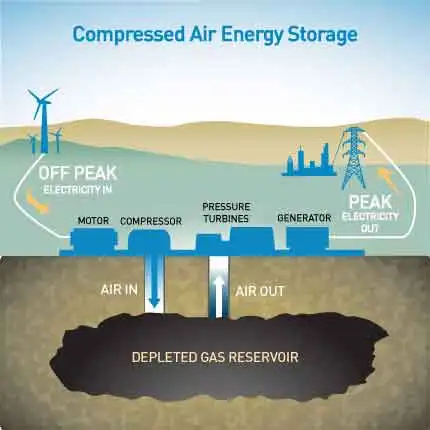
Compressed Air Energy Storage
Compressed air energy storage stores electricity by compressing air in underground caverns or tanks and releasing it later through turbines. It supports the integration of renewable energy, grid stability, and efficient large-scale storage for industrial and utility systems.
What is Compressed Air Energy Storage?
Compressed air energy storage (CAES) is a method of storing energy by compressing air, releasing it later to generate electricity.
✅ Provides large-scale renewable energy storage
✅ Enhances grid stability and efficiency
✅ Supports long-duration storage technologies
Energy Storage Systems Training
Compressed air energy storage technology is a promising solution to the global energy storage (ES) challenge. It offers high storage capacity, long system life, and clean operation. While energy efficiency remains relatively low and installations require specific geological conditions, its advantages often outweigh the drawbacks, making CAES a viable option for balancing electricity supply and demand from renewable sources. With continued innovation, CAES is expected to play an increasingly significant role in long-duration ES. Compressed air energy storage is part of the wider family of energy storage technologies that help balance electricity supply and demand across modern power grids.
Types of Compressed Air Energy Storage (CAES)
There are several configurations of CAES, each with distinct features and trade-offs:
-
Diabatic CAES: The most common design, used in existing plants like Huntorf, Germany. Heat from compression is released into the environment, reducing round-trip efficiency to around 40–55%.
-
Adiabatic CAES (A-CAES): Stores the heat generated during compression in thermal storage systems, later reusing it during expansion. Efficiency improves significantly, often projected above 65%.
-
Isothermal CAES: Maintains near-constant temperature during compression and expansion, reducing losses. Still largely experimental due to technical challenges.
-
Hybrid CAES: Combines CAES with batteries, hydrogen, or other storage systems, improving flexibility and overall efficiency.
Understanding how CAES fits into energy storage and the grid highlights its role in integrating renewable energy, shaving peaks, and stabilizing frequency.
Real-World Examples of CAES Projects
-
Huntorf, Germany (290 MW, commissioned 1978): The world’s first grid-connected CAES plant, used primarily for peak shaving.
-
McIntosh, Alabama, USA (110 MW, 1991): Introduced natural gas-fired turbines for reheat, improving efficiency.
-
Hydrostor (Canada): A leading developer of adiabatic CAES projects, leveraging salt caverns and advanced thermal storage.
-
Nengchu-1, China (300 MW, 2022): A new large-scale CAES project highlighting Asia’s growing role in grid-scale storage.
These plants demonstrate CAES’s proven long-duration capability, with storage durations ranging from 4 to 24 hours and performance measured by capacity factor, grid support, and dispatch reliability.
How does Compressed Air Energy Storage work?
CAES technology stores energy by compressing air to high pressure in storage vessels or caverns, where it can be held for hours or even days. When demand rises, the compressed air is released, passes through turbines, and generates electricity.
Heat generated during compression, often wasted in early systems, can be captured in thermal ES and reused. This increases round-trip efficiency, typically raising it into the 60–70% range in advanced systems. Still, off-design performance, heat transfer losses, and pressure drops remain significant engineering challenges.
Advantages of Compressed Air Energy Storage
CAES technology has several advantages over other ES systems. Firstly, it has a high storage capacity, allowing it to store energy for extended periods. Secondly, it is a clean technology that doesn't emit pollutants or greenhouse gases during energy generation. Additionally, CAES systems can be located near power plants or the electricity grid, reducing transmission losses and increasing trip efficiency.
-
High storage capacity: Suitable for multi-hour to seasonal storage.
-
Clean technology: Produces no emissions during storage or release.
-
Durability: Systems have long operational lifetimes, often 30+ years.
-
Grid-scale application: Can stabilize frequency, reduce transmission losses, and integrate with renewables.
Like CAES, battery energy storage systems are widely used, but they are more effective for short-duration applications rather than multi-hour or seasonal storage.
Compressed Air Energy Storage (CAES) vs Other Energy Storage Systems
Various energy storage systems are available, including pumped hydro, battery energy storage, flywheel energy storage, thermal energy storage, hydrogen energy storage, supercapacitor energy storage, compressed natural gas (CNG) storage, and mechanical energy storage. Let's compare CAES with some of these systems.
Pumped hydro is one of the oldest and most widely used energy storage systems. It uses the gravitational potential energy of water stored at a height to generate electricity. However, the construction of pumped hydro energy storage systems is expensive and requires specific geographic conditions.
Battery is another popular system that uses chemical energy to store electricity. It is a highly efficient system with a low discharge rate but limited storage capacity and high costs.
Flywheel systems store energy in a rotating flywheel, which can be later used to generate electricity. They have a low discharge rate and can respond quickly to changes in demand. However, they have a low storage capacity and high initial investment costs. Researchers also compare CAES with alternative mechanical systems, including flywheel energy storage and gravity energy storage, each offering unique performance characteristics.
Thermal systems store energy in the form of heat, which can later be converted into electricity. Therefore, they have a high storage capacity and can be used for heating and cooling. However, the efficiency of the system depends on the type of material used for thermal energy storage.
Hydrogen systems store energy in the form of hydrogen gas, which can later be converted into electricity. It is a clean and efficient system, but it has limited storage capacity and requires expensive equipment. Long-term solutions, such as CAES, are essential when compared with other approaches, like hydrogen energy storage, which is clean but currently more costly and less efficient.
A compressed natural gas (CNG) storage system stores energy in the form of compressed natural gas. It has a high storage capacity and can be used for heating and transportation. However, the conversion process is expensive and emits greenhouse gases during the process.
Supercapacitor systems are capable of storing and releasing large amounts of energy in a short time. They have a long life cycle, but a low energy density and limited storage capacity.
CAES technology offers a viable solution to the energy storage problem. It has a high storage capacity, is a clean technology, and has a long life cycle. Additionally, it can utilize existing natural gas infrastructure, reducing initial investment costs.
Comparison of Energy Storage Systems
| Feature | CAES | Pumped Hydro | Lithium-ion Battery Storage |
|---|---|---|---|
| Technology type | Mechanical (compressed air in caverns or tanks) | Mechanical (water stored at elevation) | Electrochemical (chemical-to-electrical conversion) |
| Typical efficiency | 45–70% (higher in adiabatic designs) | 70–85% | 85–95% |
| Storage duration | 4–24 hours (potentially days with large caverns) | 6–20 hours | Minutes to ~8 hours |
| Capital cost | $1,000–1,500/kW | $1,500–2,500/kW | $400–800/kWh |
| Scale | 50–500 MW (utility-scale) | 100 MW–1 GW (large infrastructure) | 1 kW–100 MW (flexible deployment) |
| Geographic requirements | Underground salt caverns, porous rock, or tanks | Significant elevation difference and water availability | Few site restrictions, deployable almost anywhere |
| Lifetime | 30–40 years | 40–60 years | 8–15 years |
| Best applications | Long-duration grid storage, renewable integration, peak shaving | Bulk storage, baseload shifting, seasonal storage | Short-duration storage, fast response, frequency regulation |
Economic and Cost Considerations
CAES economics depend on site geology, capital cost, and market conditions. Estimated capital costs range between $1,000 and $ 1,500/kW, with round-trip efficiencies of 45–70%. While batteries dominate short-duration markets, CAES offers lower costs for long-duration storage compared to lithium-ion batteries at scales of 8 hours or more. Pumped hydro remains the closest competitor, but CAES requires less topographical limitation if suitable caverns are available.
Key cost drivers include cavern construction, compressor/turbine efficiency, and electricity prices. Research shows CAES becomes more competitive in systems with high renewable penetration and volatile market pricing.
CAES Compared with Other Energy Storage Systems
-
Pumped Hydro: Mature and efficient but geographically limited.
-
Batteries: High efficiency and flexibility, but expensive at long durations.
-
Flywheels: Fast response but low storage capacity.
-
Thermal Storage: Ideal for heat applications; efficiency varies depending on the materials used.
-
Hydrogen: Clean but less efficient and more costly at present.
A comparison shows that CAES is uniquely positioned for grid-scale, long-duration ES, where geology supports it. The importance of CAES becomes clear when viewed in the context of long-term energy storage, where extended duration and grid reliability are critical.
Challenges and Limitations of CAES
-
Low efficiency compared to batteries (60–70% vs 85–95%).
-
Site limitations: Requires salt caverns or porous rock formations.
-
Geological risks: Cavern fatigue, leakage, sealing, and stress cycling.
-
Environmental impact: Land use, embodied energy, and potential CO₂ footprint.
-
High upfront costs and regulatory complexity for permitting.
As global demand rises, innovations in CAES contribute to the overall growth in utility-scale energy storage, positioning it as a leading solution for future energy systems.
Integration with Renewables and the Grid
CAES complements variable renewables, such as wind and solar, by storing excess energy and providing power during periods of peak demand. Applications include:
-
Shifting renewable output to match demand patterns.
-
Peak shaving and demand response to reduce grid strain.
-
Frequency regulation and ancillary services for grid stability.
-
Hybrid integration with batteries or hydrogen for flexibility.
This makes CAES attractive for energy arbitrage and balancing in high-renewable systems.
Future Outlook for Compressed Air Energy Storage
CAES is evolving through research into adiabatic and isothermal systems, improved thermal ES, advanced materials for compressors/expanders, and hybrid designs combining CAES with batteries or hydrogen. Policy incentives, carbon pricing, and long-duration storage mandates are expected to accelerate deployment.
Research gaps remain in cost reduction, long-term testing, and commercialization. Still, as of 2025, CAES is positioned as one of the most promising long-duration ES technologies for the future grid.
Frequently Asked Questions
What type of energy is stored in compressed air?
CAES stores potential energy in pressurized air. When released, the air expands through turbines, generating electricity.
What is the main problem with CAES?
The main drawback is low efficiency due to heat losses during compression and the high energy needed for re-compression.
How efficient is CAES?
Typical CAES systems achieve an efficiency of 60–70%, depending on the configuration and site conditions.
Where can CAES be built?
Most systems require salt caverns or underground formations, which limit the number of available installation sites but enable large-scale storage in suitable locations.
Related Articles
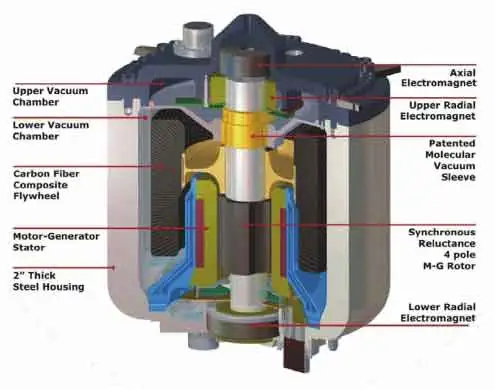
Flywheel Energy Storage vs. Other Technologies
Flywheel energy storage systems store kinetic energy in rotating mass to deliver rapid response, improve grid stability, and support renewable integration with high efficiency, reliability, long cycle life, low environmental impact, and sustainable performance.
What is Flywheel Energy Storage?
Flywheel energy storage (FES) is a mechanical system that stores energy in a rotating mass to deliver electricity quickly and efficiently.
✅ Provides rapid response for grid stability and renewable integration
✅ Offers long cycle life with minimal maintenance needs
✅ Enhances energy efficiency and reduces environmental impact
Flywheel energy storage is a promising technology for energy storage with several advantages over other energy storage technologies. Flywheels are efficient, have a longer lifespan, and can provide fast response times to changes in power demand. In addition, Flywheel systems have numerous applications, including grid stabilization, backup power, and UPS systems. While FES is still in the development and commercialization stage, ongoing research and development are expected to lead to further technological improvements, making it a more competitive option in the global energy mix.
Energy Storage Systems Training
How Does Flywheel Energy Storage Work?
FES works by converting electrical energy into kinetic energy stored in a high-speed rotor. A typical system includes a flywheel rotor made of steel or advanced composites, housed in a vacuum enclosure to minimize air drag. Bearings—mechanical, magnetic, or superconducting—support the rotor and reduce friction. Power electronics connect the flywheel to the grid or local load.
When electricity is supplied, the motor accelerates the rotor, storing energy as rotational kinetic energy. When electricity is required, the generator decelerates the rotor, converting the kinetic energy back into electrical energy. Magnetic and superconducting bearings, along with vacuum containment, help minimize losses and extend operational life.
Energy storage capacity is often measured in watt-hours per kilogram (Wh/kg), while response speed and round-trip efficiency (typically 70–90%) make flywheels competitive for short-duration, high-power applications.
Advantages and Disadvantages
One of the primary advantages of flywheels is their ability to respond almost instantly to fluctuations in power demand. Their long cycle life—often exceeding two decades—makes them sustainable compared to chemical batteries. Flywheels also exhibit minimal degradation over thousands of charge-discharge cycles and support ancillary services like frequency regulation.
However, challenges remain. Frictional and standby losses can reduce stored energy over time, even in vacuum-sealed systems. High rotational speeds demand strong, lightweight rotor materials such as carbon fiber composites, which increase manufacturing costs. Safety containment is crucial for handling potential rotor failure under extreme stress, which adds complexity and cost.
Flywheel Energy Storage Applications
Flywheel systems have been deployed across multiple sectors:
-
Grid Stabilization: Flywheels provide frequency regulation and voltage support, responding to demand spikes in milliseconds. Beacon Power has operated flywheel plants in the U.S. for grid ancillary services.
-
Backup Power and UPS Systems: In data centers, hospitals, and industrial facilities, flywheels serve as reliable, fast-response UPS solutions, reducing reliance on chemical batteries.
-
Transportation and Aerospace: Compact flywheel systems have been tested for buses, trains, and aircraft to recover braking energy and reduce fuel use.
-
Microgrids and Renewables Integration: Flywheels smooth variability from wind and solar power, stabilizing hybrid systems in remote or island grids.
Benchmarking Flywheel vs Other Energy Storage Technologies
| Technology | Energy Density (Wh/kg) | Cycle Life | Response Time | Typical Applications |
|---|---|---|---|---|
| Flywheel | 20–80 | >20 years, >100k | Milliseconds | Grid stability, UPS, short bursts |
| Lithium-ion Battery | 100–250 | 5–15 years | Seconds | EVs, portable electronics, grid storage |
| Supercapacitor | 5–10 | >1M cycles | Milliseconds | Power quality, regenerative braking |
| Pumped Hydro | 0.5–1 | 30–60 years | Minutes | Bulk, long-duration energy storage |
| Compressed Air | 2–6 | 20–40 years | Minutes | Grid-scale long-term storage |
This comparison highlights where flywheels excel: ultra-fast response, long cycle life, and high power density, but lower energy density than batteries or hydro.
Efficiency and Performance
Flywheel systems typically achieve round-trip efficiencies of 70–90%. Losses occur from friction, magnetic drag, and electrical conversion. Unlike chemical batteries, flywheels self-discharge more quickly, making them better suited for short-term storage rather than long-duration energy shifting.
Still, their high power density, fast ramp rate, and low lifecycle cost per cycle make them ideal for applications needing immediate power injection.
Market Outlook and Adoption
The global FES market is expanding, projected to grow from USD 351.94 million in 2025 to USD 564.91 million by 2032, at a CAGR of nearly 7% (Fortune Business Insights).
Leading companies such as Beacon Power, Amber Kinetics, and Temporal Power have demonstrated commercial-scale flywheel projects for grid regulation and UPS. While adoption lags behind batteries, niche markets like microgrids, critical facilities, and renewable integration are driving growth.
Challenges include high upfront costs, rotor safety concerns, and competition from falling battery prices. However, ongoing research is improving rotor materials, reducing friction losses, and lowering costs.
Future Trends and Research Directions
Flywheel development continues to advance with several key innovations:
-
Advanced Bearings: Active magnetic and superconducting bearings reduce friction and extend operational life.
-
Composite Rotors: High-strength carbon fiber improves energy density while reducing rotor mass.
-
Hybrid Systems: Integration with batteries or supercapacitors creates systems that combine high energy and high power.
-
Scalability and Modularization: Modular flywheels for microgrids and distributed energy resources are under active development.
-
Sustainability: Unlike chemical batteries, flywheels contain no toxic materials and are fully recyclable, making them attractive for green infrastructure.
Challenges and Limitations
Despite their advantages, flywheels face challenges in adoption. High-speed rotation requires costly materials and precision engineering. Safety containment must be robust to prevent catastrophic failure. Standby losses limit long-duration storage applications. Regulatory standards and market structures also influence their competitiveness compared to established technologies, such as lithium-ion.
Addressing these barriers is crucial for the broader adoption of energy storage in global markets.
Frequently Asked Questions
How long can a flywheel store energy?
Typically from seconds to several hours, depending on rotor design, size, and bearing technology. They are most efficient for short-duration, high-power applications.
What limits flywheel energy storage?
The strength of the rotor material, frictional losses, and the cost of high-speed composite rotors are the primary limiting factors.
Is flywheel storage better than batteries?
For short-term, high-power needs and frequent cycling, yes. For long-duration storage, batteries are typically more practical.
What is the efficiency of flywheels?
Round-trip efficiency ranges between 70–90%, with losses from bearings, vacuum drag, and electrical conversion.
Where are flywheels used today?
They are deployed in grid stabilization plants, UPS systems for data centers and hospitals, microgrids, and experimental transport systems.
Related Articles

Gravity Energy Storage Explained
Gravity Energy Storage stores renewable electricity by lifting and lowering heavy masses, converting potential energy into power. It supports grid stability, clean energy storage technologies, and the integration of long-duration renewable energy sources.
What is Gravity Energy Storage?
Gravity energy storage is a renewable energy technology that uses gravitational potential power from lifted weights to generate electricity when needed.
✅ Provides long-duration, large-scale renewable storage
✅ Enhances grid stability and efficiency
✅ Reduces reliance on fossil fuel backup
Energy Storage Systems Training
Gravity Energy Storage (GES) is an innovative approach to energy storage (ES) that utilizes the potential energy of heavy masses to store energy. By elevating masses, electricity is stored as gravitational potential energy, expressed as E = m × g × h (mass × gravitational acceleration × height). When released, this power converts into kinetic energy, which then generates electricity. GES systems have high energy density, long lifespans, and low environmental impact. Although they require significant infrastructure and suitable locations, they are emerging as cost-competitive solutions for long-term storage. With the ability to support renewable energy sources, GES is a promising technology for sustainable power systems. GES is one of many innovative methods in the broader energy storage sector that support the integration of renewable power and grid stability.
Renewable energy sources, such as solar and wind, are expanding rapidly; however, their intermittent nature makes reliable storage solutions essential. Energy storage systems (ESS) bridge this gap by storing surplus power and supplying electricity during periods of low output. Among these technologies, GES has gained attention as a scalable, durable, and environmentally friendly option. In this article, we explore what GES is, how it works, its advantages and disadvantages, examples, and its potential future role. Long-duration storage solutions like GES are critical for modern grids, complementing other strategies discussed in energy storage and the grid.
How Does it Work?
GES operates by storing electricity as gravitational potential energy. Heavy masses are raised during periods of surplus electricity, and when power is needed, the masses are lowered, releasing kinetic power that drives generators. Efficiency depends on minimizing energy losses during lifting and lowering, with round-trip efficiencies typically reaching 80–90%.
One of the most recognized innovations is the Energy Vault, a modular tower where concrete blocks are lifted and lowered by electric cranes. Another approach, pursued by companies like Gravitricity, uses mine shafts to raise and drop large weights. Pumped hydro, the oldest form of gravity storage, moves water to higher elevations and remains the largest deployed system worldwide. Analysts expect global growth in utility-scale energy storage, with gravity systems emerging alongside lithium-ion, hydrogen, and thermal technologies.
Types of Gravity Energy Storage
GES systems fall broadly into two categories:
-
Liquid (LGES): Includes pumped hydro, where water is pumped uphill and released downhill. Proven at scale but requires suitable terrain.
-
Solid (SGES): Uses solid masses such as concrete blocks or weights. Variants include tower-based systems, mine shaft systems, rail-based storage, and mountain slope systems. These offer flexible siting compared to pumped hydro but require substantial infrastructure.
Each approach strikes a balance among efficiency, land use, cost, and scalability.
How Efficient is GES?
GES efficiency is determined by the ratio of output electricity to input energy. The primary formula, E = mgh, illustrates how energy storage is dependent on mass, height, and the gravitational constant. Losses occur through mechanical friction, motor and generator inefficiencies, and control systems. Well-designed systems reach 80–90% round-trip efficiency, comparable to lithium-ion batteries but with longer lifespans and lower degradation.
What is the Problem with the Gravity Battery?
Despite strong potential, GES faces limitations. Systems require substantial land or existing infrastructure like shafts. Location suitability depends on geology and available height differences. Capital costs can also be high, though life-cycle costs (LCOS) are competitive. For example, recent studies estimate GES LCOS at $100–150 per MWh, positioning it between pumped hydro and lithium-ion batteries.
Advantages and Disadvantages of GES
GES offers several benefits:
-
High electricity density and long-duration storage
-
Low environmental impact and minimal material degradation
-
Competitive long-term costs compared to chemical batteries
Challenges include:
-
High upfront capital costs
-
Location and infrastructure constraints
-
Land use and ecosystem impacts if poorly sited
How Does GES Compare to Other Forms of ES?
GES compares favorably with other storage technologies:
-
Lithium-ion batteries: High efficiency and fast response but degrade over time and have higher environmental impact. Compared to batteries, a battery energy storage system offers faster response but shorter lifespans, making gravity storage more attractive for long-duration applications.
-
CAES: Scalable but less efficient and geology-dependent. Similar to how compressed air energy storage uses underground caverns to balance supply and demand, gravity systems rely on height and mass to provide dispatchable electricity.
-
Hydrogen storage: Long-term seasonal storage but low round-trip efficiency. For seasonal or ultra-long storage, gravity systems can complement hydrogen electricity storage strategies, as discussed in that Hydrogen Energy Storage review.
| Technology | Efficiency | Duration | Scalability | Environmental Impact | Cost Trend |
|---|---|---|---|---|---|
| GES | 80–90% | Hours–days | High | Low | Competitive |
| Li-ion | 85–95% | Minutes–hours | Medium | Moderate–High | Falling but resource-limited |
| CAES | 50–70% | Hours–days | High | Moderate | Location-dependent |
| Hydrogen | 30–50% | Weeks–months | Very high | Variable | Currently expensive |
Examples of Gravity Energy Storage Systems
-
Energy Vault: A 35-ton tower using modular blocks, capable of storing up to 20 MWh.
-
Gravitricity: Demonstrations in disused mine shafts in Scotland, exploring up to 24 MWh capacities.
-
Pumped Hydro: The most established form, accounting for over 90% of global storage capacity.
These examples highlight the range of approaches and show how GES can scale from pilot projects to grid-level deployments.
What is the Potential for GES on a Large Scale?
GES has strong potential to complement renewable power. By storing excess solar and wind output, it can deliver dispatchable power on demand. Hybrid systems that combine GES with batteries or hydrogen can optimize flexibility, addressing both short-term and seasonal energy needs. Analysts expect global growth in utility-scale energy storage, with gravity systems emerging alongside lithium-ion, hydrogen, and thermal technologies.
What are the Environmental Impacts of GES Systems, and How Can They be Mitigated?
GES has a lower lifecycle environmental impact compared to lithium-ion batteries, as it avoids the use of mining-intensive materials. However, large land requirements and infrastructure development can disrupt ecosystems. Careful siting, thorough environmental impact assessments, and the use of existing infrastructure (e.g., abandoned mines) help mitigate potential impacts. Long-duration storage solutions like GES are critical for modern grids, complementing other strategies discussed in energy storage and the grid.
Future Outlook for Gravity Energy Storage
Looking ahead, GES is poised to be a key player in long-duration energy storage (LDES). Advances in modular tower systems, repurposing mines, and innovative hybrid storage concepts are expanding deployment options. Policy support, carbon reduction targets, and rising renewable penetration all drive investment. As costs decline and pilot projects prove scalability, GES could become a mainstream solution for global renewable integration. Hybrid approaches that integrate GES with chemical or mechanical storage resemble concepts in hybrid energy storage systems, combining strengths of multiple technologies.
Related Articles
Where are energy storage systems operating in the United States?
Energy Storage Systems in the USA enable grid-scale resilience, integrating renewables with battery storage, BESS, inverters, and power electronics for peak shaving, frequency regulation, microgrids, and smart grid reliability across sectors.
What Are Energy Storage Systems in the USA?
Battery and power-electronics systems that store electricity, stabilize the grid, and enable renewable integration
✅ Provide frequency regulation, voltage support, and black-start capability
✅ Use Li-ion, flow batteries, flywheels, and ultracapacitors
✅ Integrate bi-directional inverters, EMS, SCADA, and microgrid controls
Where are energy storage systems operating in the United States?
Energy storage systems operate in various locations throughout the United States, with many states actively promoting the deployment of energy storage to support the integration of renewable energy sources into the electrical power grid. Some states leading the way in energy storage deployment include California, Texas, and Hawaii. For readers new to the concept, this overview of what energy storage is provides helpful context for policy and deployment trends.
California has been one of the most active states in promoting the deployment of energy storage, with a target of 1,325 MW of energy storage capacity by 2024. The state has several large-scale energy storage projects, including the 300 MW/1,200 MWh Moss Landing Energy Storage Facility, one of the world's largest battery energy storage systems. In addition, the state is also home to many smaller-scale energy storage systems, such as residential and commercial battery systems. Given the state's vast solar resources, this primer on solar energy storage explains how batteries capture midday generation for evening demand.
Texas is another state that has been actively promoting the deployment of energy storage, with a goal of 5 GW of energy storage capacity by 2030. The state has several large-scale energy storage projects, including the 495 MW/1,993 MWh Samson Energy Storage Project, which will be the largest energy storage project in the United States when it is completed. In addition, the state is also home to several smaller-scale energy storage projects, including battery systems for residential and commercial use. The rapid growth in utility-scale energy storage is reshaping ERCOT's resource mix and ancillary services.
Hawaii has set a goal of achieving 100% renewable energy by 2045, and energy storage is an integral part of the state's strategy to achieve this goal. The state has several large-scale energy storage projects, including the 36 MW/144 MWh Kapolei Energy Storage Project, Hawaii's largest energy storage project. In addition, the state is also home to many smaller-scale energy storage projects, including residential and commercial battery systems. Isolated island grids also benefit from advances in long-duration energy storage that can ride through prolonged cloudy or low-wind periods.
Other states that have been actively promoting the deployment of energy storage include New York, Massachusetts, and Arizona. In New York, the state has a goal of 3 GW of energy storage capacity by 2030. It has several large-scale energy storage projects, including the 20 MW/20 MWh Hecate Energy Queens Lithium-ion Battery Storage System. Massachusetts has set a goal of 1,000 MWh of energy storage capacity by 2025 and has several energy storage projects in operation, including a 20 MW/20 MWh battery storage project in Worcester. Arizona has several large-scale energy storage projects, including the 100 MW/400 MWh Sonoran Energy Center Battery Storage Facility, one of the most significant battery storage projects in the United States. Across these regions, the interaction between energy storage and the grid helps balance peaks, reduce curtailment, and enhance resilience.
Overall, energy storage systems are operating in various locations throughout the United States, with many states actively promoting their deployment to support the integration of renewable energy sources and improve the stability and reliability of the electrical power grid. Analysts track the expanding sector in reports on how big the energy storage market is, highlighting investment trends across technologies. Ultimately, understanding why we need energy storage underscores its value for reliability, decarbonization, and cost efficiency.
Related Articles
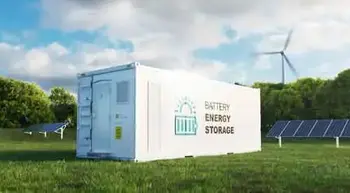
Battery Energy Storage System Technology
Battery Energy Storage System (BESS) technology stores electricity for later use, supporting renewable energy, grid stability, and peak demand management. These systems improve energy efficiency, reliability, and sustainability across power distribution networks.
What is a Battery Energy Storage System?
A Battery Energy Storage System (BESS) is a technology that captures and stores electrical energy for later use, thereby enhancing grid reliability, facilitating the integration of renewable energy sources, and improving energy management.
✅ Provides backup power and peak demand control
✅ Supports renewable energy sources like solar and wind
✅ Improves grid stability, efficiency, and reliability
A battery energy storage system is an energy storage solution that cost-effectively stores electricity in rechargeable batteries for later use. It is a type of energy storage (ES) system that uses batteries to store and discharge electricity.
BESS stores electricity when it is generated in excess and then releases it back into the grid or uses it when the electricity supply is limited. It can also serve as a backup power supply in the event of power outages or to stabilize the grid during periods of high demand. Our Energy Storage Channel provides a complete overview of technologies and trends shaping the future of electricity storage.
Visit our Energy Storage System Training Course Page
A battery energy storage system typically consists of a set of batteries, power conditioning equipment such as inverters, and a control system that manages the charging and discharging of the batteries. The batteries used in BESS can vary from lead-acid to lithium-ion and other advanced chemistries, depending on the specific requirements of the application. Alternative storage technologies like Capacitor Energy Storage and Flywheel Energy Storage are being developed for specialized applications.
BESS has become an increasingly important energy storage solution as renewable energy sources, such as wind and solar power, have become more prevalent. This can provide a means of storing energy during times of excess generation for use during periods of low demand. Additionally, BESS can help to reduce the need for fossil fuel-powered peaker plants, which are used to meet peak demand but can be expensive and environmentally damaging. BESS can store the power generated by solar power systems. Large-scale solutions such as Compressed Air Energy Storage and Gravity Energy Storage highlight the diversity of methods available for balancing the grid.
Frequently Asked Questions
How does a battery energy storage system work?
A BESS works by storing electrical power in batteries for later use. The basic operation of a BESS can be broken down into several steps:
Charging: Electrical power is supplied to the battery to charge it. This can be achieved through various sources, including renewable energy sources such as solar and wind power, or by utilizing the grid during periods of low demand.
Storage Technologies: Once the batteries are charged, they store the electrical energy until it is needed. The amount of power stored in the batteries depends on the system's capacity.
Discharging: The batteries release the stored power when electrical power is needed. This can be done by converting the DC power from the batteries to AC power using an inverter. The amount of energy released depends on the demand and the capacity of the system.
Monitoring and Control: The BESS is typically monitored and controlled by a control system that manages the charging and discharging of the batteries. This control system ensures that the batteries are charged and discharged safely and efficiently, and operate within their design limits.
Overall, a BESS can provide a means of storing excess power from renewable sources for later use, reducing peak demand on the grid, providing backup power during outages, and improving the stability and reliability of the electrical grid.
What are the benefits of a battery energy storage system?
There are several benefits of a BESS, including:
Renewable Energy Integration: BESS can store excess power generated by renewable energy sources, such as solar and wind power, for use when energy demand exceeds power generation.
Peak Demand Management: BESS can help reduce demand during peak times by peak shaving, thereby limiting the need for utilities to bring on expensive and environmentally harmful peaker plants to meet high electricity demands.
Grid Stability and Reliability: BESS can provide a stable and reliable power supply, especially during outages or emergencies. BESS can also provide ancillary services to the grid, such as frequency regulation, voltage support, and ramp rate control. To understand the broader impact, see our analysis of Energy Storage and the Grid and the Growth in Utility-Scale Energy Storage.
Cost Savings: BESS can help businesses and homeowners reduce their electricity costs by storing and utilizing cheaper off-peak electricity during peak periods.
Environmental Benefits: BESS can help reduce greenhouse gas emissions by enabling the integration of more renewable power into the grid and reducing the need for fossil fuel-powered peaker plants.
Energy Independence: BESS can provide a backup power supply during power outages or emergencies, providing energy independence and reducing reliance on the grid.
Overall, BESS can help improve the electrical grid's efficiency, reliability, and sustainability while providing businesses and homeowners with cost savings and energy independence.
How efficient is BESS?
The efficiency of a BESS can vary depending on several factors, such as the type of chemistry used, the temperature and operating conditions, and the efficiency of the power electronics and control systems used to manage the batteries.
Generally, the round-trip efficiency of a BESS, which is the ratio of the power output to the power input, can range from around 70% to 95%. This means that if you put 100 units of power into the battery, you may get anywhere from 70 to 95 units of power back out, depending on the system's efficiency.
Lithium-ion batteries, commonly used in BESS applications, have a round-trip efficiency of around 80-90%, while lead-acid batteries have a round-trip efficiency of about 70-80%. Other types of batteries, such as flow batteries, may have higher round-trip efficiencies of up to 95%.
It's important to note that efficiency is not the only factor to consider when evaluating the performance of a BESS. Other factors such as cost, lifespan, safety, and environmental impact are also important considerations.
Related Articles






